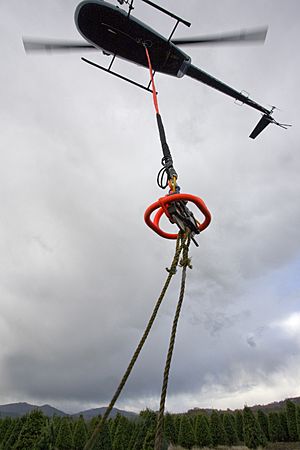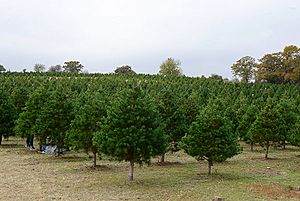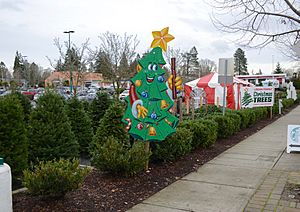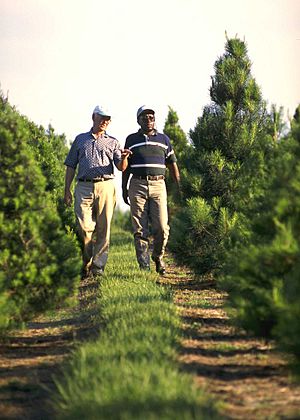Christmas tree production in the United States facts for kids
Growing Christmas trees on farms is a big business in the United States. While the very first Christmas tree farm might have started around 1901, most Christmas trees sold in the U.S. came from natural forests until the 1950s. Today, states like Wisconsin, North Carolina, Pennsylvania, and those in the Pacific Northwest are major Christmas tree producers. In 2002, the U.S. grew about 20.8 million Christmas trees. This made the U.S. one of the world's top producers of real Christmas trees. That same year, Pennsylvania grew the most trees in the country.
Contents
How Christmas Tree Farming Grew
The first Christmas tree farm in the U.S. is thought to have started in 1901. A person named W. V. McGalliard planted 25,000 Norway Spruce trees in New Jersey. He sold them seven years later for $1.00 each.
Even with these early farms, most Christmas trees in the late 1940s still came from wild forests. Popular trees like Balsam Fir, Douglas-fir, and White Spruce were easy to find in nature.
After World War II, more trees began to be planted on special farms called plantations. Farmers also started trimming their trees in the late 1940s and early 1950s. This "shearing" made the trees grow thicker and fuller, which customers liked.
During the 1960s, the Christmas tree market changed. Many part-time growers stopped, while others grew their farms and became full-time Christmas tree farmers. This growth happened in important areas like Michigan, the Pacific Northwest, and North Carolina.
More trees were planted in the late 1970s and into the 1980s. From 1977 to 1979, the U.S. produced about 29 million Christmas trees each year. Farmers even started using Helicopters in the early 1980s. Helicopters helped move trees from the fields to the shipping areas faster. Between 1988 and 1994, about 34–36 million Christmas trees were harvested in the U.S. every year.
In 2002, there were 21,904 Christmas tree farms in the U.S. These farms covered about 447,000 acres of land. They produced 20.8 million cut Christmas trees. Pennsylvania had the most farms, with 2,164. However, Oregon had the most land used for Christmas tree farming, with 67,800 acres.
By 2004, the total value of Christmas trees grown in the U.S. was $506 million. Oregon was the top producer that year, making $143 million. Other top states included North Carolina, Washington, and Michigan.
Christmas Tree Farming in North Carolina
In 2002, North Carolina harvested about 2.9 million Christmas trees. This made it the second-largest producer after Oregon. By 2004, the trees grown in North Carolina were worth over $100 million. The North Carolina Department of Agriculture says that 18% of all natural Christmas trees harvested in the U.S. come from North Carolina. About 1,500 growers in the state plant 42 million trees.
Christmas Tree Farming in the Pacific Northwest
Oregon and Washington are very important states for growing Christmas trees. About 92% of the trees grown here are Douglas fir and Noble fir. Other types include grand fir and Nordmann fir.
Most Christmas trees grown in the Pacific Northwest are sent to other places. About 92% of them are shipped out of the region. California buys the most, taking 45% of the trees. Other countries like China, Japan, Mexico, and the Philippines also buy many trees from this region.
In 2015, Oregon had about 700 Christmas tree farms. They covered 63,000 acres and produced 7.2 million trees. These trees were worth about $120 million. Most of Oregon's Christmas tree farming happens in the Willamette Valley.
In 2015, Washington State had about 250 Christmas tree farms. They covered 23,000 acres and produced 2.3 million trees. These were valued at about $35 million. Most of Washington's Christmas tree farming is in the western and southern parts of the Puget Sound area.
Christmas Tree Farming in the Great Lakes States
Besides Pennsylvania, some states in the Great Lakes region are also big Christmas tree producers. The two most important are Michigan and Wisconsin.
Michigan's Christmas tree industry is worth around $60 million each year. About 75% of the trees from Michigan's 850 farms are sold outside the state. In 2004, Christmas tree farms in Michigan covered 54,000 acres. Areas around Manton and Lake City are known for growing many trees. Lake City is even called Michigan's "Christmas Tree Capital."
Christmas Tree Farming in Other Regions
Christmas trees are grown all over the United States, even in Alaska and Hawaii. In Alabama, there are nearly 100 Christmas tree farms. They grow about 800 trees each year. Most of Alabama's farms let customers visit and cut down their own trees. This is called "choose and cut."
The Christmas Tree Market
The first commercial Christmas tree market began around Christmas 1851. A farmer named Mark Carr from New York's Catskill Mountains brought a load of Christmas trees to New York City. He sold all of them. Even though trees were sold commercially then, the first American Christmas tree farm didn't start until about 50 years later. Before that, most U.S. Christmas trees came from forests. Today, 98% of all real Christmas trees sold worldwide are grown on farms.
The market for real Christmas trees in the U.S. faced challenges in the late 1980s and mid-1990s. There were too many trees, which caused prices to drop. For example, in 1992, trees in New England sold for about $5, much less than the usual $18–$30. The use of real Christmas trees continued to go down partly because fake trees became more popular. Many growers in states that didn't produce many trees went out of business.
In 1998, a big ice storm hit North America. It damaged many Christmas trees in eastern Ontario and Quebec. Farmers received money from the Canadian government to help them recover.
Real Trees Versus Artificial Trees
In 1992, about 46% of U.S. homes with Christmas trees had an artificial tree. Twelve years later, in 2004, a survey showed that 58% of U.S. homes used a fake tree instead of a real one. The discussion about real versus artificial trees is often talked about in the news around Christmas.
News stories in the early 2000s often focused on how sales of real trees were falling while sales of fake trees were rising. In 2004, the U.S. Christmas tree industry tried to boost sales of real trees. They started an advertising campaign to encourage people to buy natural trees.
In 1990, about 35 million U.S. homes had real Christmas trees. This was slightly less than the 36.3 million homes that chose artificial trees. By 2000, the difference was even bigger. 50.6 million homes used artificial trees, while 32 million chose real ones. Sales of real trees kept dropping. By 2003, only 23.4 million real trees were sold. At the same time, sales of artificial trees went up from 7.3 million to 9.6 million each year.
See also





